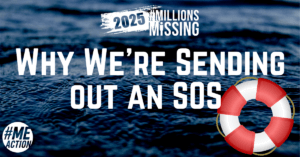Biomarkers are a holy grail for ME/CFS because they have the potential to help diagnose disease, track disease progression or progress and help inform which treatments might help.
The need for biomarkers is immense and researchers will identify many possible ones. It is encouraging that there have been more possible biomarker reports recently. It can be so hard to hold onto hope, and the news of progress helps so many of us hang in there when living with this disease is so tough.
As ME/CFS slowly heads into a new era with increased research, our community should begin to see increasing numbers of biomarker headlines. Yet many people may start to feel quite confused: so many reports, but where is the one true biomarker?
A tale of caution
Each report of a promising new biomarker can lift our spirits very high, only for them to crash down again if the biomarker doesn’t progress. Media headlines can be quite sensational, designed to attract readers and often promising more than the research has delivered. Of course, researchers need to battle for funding dollars, and media attention can help their grant applications so there’s always the temptation to hype their current work.
Over the years many promising biomarkers have been reported, but as yet not one has quite made it to the finishing line. Our team would like to encourage caution as more findings get reported. There is much work and many hoops to jump through before biomarkers can reach the finish line at the doctors’ office.
Acclaimed science writer and author Julie Rehmeyer, a well-known ME/CFS advocate, recently wrote about biomarker claims on her Facebook page. She has kindly let us share her comments:
“A note of caution to my ME/CFS friends: Many research groups have claimed recently that they’re close to having a biomarker, and it’s thrilling to finally see some really good biomedical research happening.
Some of the recent findings have enormous potential.
BUT. We’re probably still years away from having a biomarker.
Here’s the thing: Imagine yourself as a scientist working on this disease. You of course want to find a biomarker, because we really, really need one. So you focus your work on that, and you get some kind of interesting but preliminary result, and some journalist comes along and asks you why it matters. Watcha gonna say? You’re going to say, “This will lead to a biomarker.” Especially because you’re only going to get funding to continue your research if the right people think you’re on the right track.
But most early results are wrong. And even when they’re right, it’s usually more complicated than anyone thought, with big big problems that arise along the way and have to be solved. It’s just a really long and uncertain road to go from some promising result to a test you can order at Quest.
So yes, we’ve got some great scientists doing great work, and that’s a BIG CHANGE we should be thrilled about. And of course, we should hold them accountable to produce real-world results that matter to us. But we should also be realistic. Science is hard. It’s really, really hard — even in the best of circumstances, without the huge political problems facing ME/CFS.”
Beware the biomarker rollercoaster
The picture for ME/CFS is complex. Biomarkers have to make it through a long journey of investigation and require thorough validation. A lot of work is required to clarify how they may relate to the disease pathophysiology, and compare them with other diseases. It’s particularly important to compare findings with patients who have diseases with similar symptoms, to show that the biomarker is specific for ME/CFS and not a general marker of fatigue or ill-health.
Large studies are needed on many well characterized patients across age and stage of disease, and different subgroups to really understand what they might mean and their possible overall usefulness. It is likely that different biomarkers or sets of biomarkers may be needed for different subgroups.
Want to learn more about biomarkers?
The winter Solve ME/CFS Initiative Chronicle has some excellent information on page 9 explaining about what makes good biomarkers and how the many we have found have not quite cut it.

It isn’t bad news!
Yes, it could take years for patients to be able to have an “ME/CFS test” in a mainstream doctor’s office – because of the time it takes to do quality research, and the lack of funds. But there are now real reasons for hope, more than ever before!
Stronger research findings are emerging, increasingly we see positive media coverage, collaborations are building and the National Institutes of Health has made some commitment. Momentum is building. Importantly, some breakthrough might emerge meaning that effective treatments come even before biomarkers do.
The situation for patients can change fast, as Julie also beautifully highlights:
“There’s now some real, high-quality science happening — not as much as we’d like because of the ridiculously small research funding, but we have some really committed, top-notch scientists committed to understanding our disease, We’ve got David Tuller and Miriam E. Tucker regularly producing highly scientifically informed stories, and a number of other journalists who aren’t so focused on the illness but are producing occasional good stories (plus me, in my weird little niche). And the NIH — well, hard to know what to say there. But it’s not the total frozen deadlock that it was six years ago.”
None of that is what we deserve, of course. We deserve BIG money, a whole tribe of researchers, a crew of informed, interested journalists. But I think it might be enough: enough to produce real change, in a reasonable amount of time, that will make our lives easier.
The thing that will change everything is when we get a compelling story about the pathophysiology of this disease — what the hell is going wrong inside our bodies. The various findings about metabolism in ME/CFS hint at such a story. And, being optimistic, we might learn enough in the next, say, three years, that it goes beyond feeling like hints and turns into a real story people can stick into their heads and hold onto.”
“I also think it might lead to treatments fast. To get the kind of treatments we really want — ones that are highly effective for lots of folks — will probably take quite a while. But once we understand the basic problem driving the illness, I think doctors and researchers will quickly come up with ideas of how to address it.”
Our MDP patient teams’ big message – beware of the biomarker rollercoaster ups and downs. It is not a matter of ‘will’ we find a biomarker, we believe that pinning down mechanisms, pathways and subgroups will lead to many possible biomarkers. It’s now a question of finding the most effective ones, probably by subgroup, that will work for diagnosis, identifying the best treatment option for each patient, and measuring progress.
This article was originally published at http://microbediscovery.org/






4 thoughts on “The ME/CFS Biomarker Rollercoaster”
Somewhere Is there a list of the ME/CFS biomarkers currently under consideration with their respective researcher(s) and institutions? If not, it would be helpful to have one that is updated every time a new “potential” biomarker appears in the literature.
Gemini,
I’m not sure that I’ve seen that literature but if you come across it, please do share!
Meanwhile, here is a helpful article that Solve ME/CFS Initiative wrote in their Chronicle newsletter about biomarkers:
https://drive.google.com/open?id=0B6UlcglLsyp7WkgxbmdaWXVhbVU
The MEpedia page “Diagnostic Biomarker” seems up to date. http://me-pedia.org/wiki/Diagnostic_biomarker
My brother tested positive for HLA-B27 after ANA were high after I got disgnosed. Mayo a Rheumatology seemed highly interested until I revealed the rest of my ME bloodwork then he bailed saying it was over his head.
Lara D Henderson
Comments are closed.